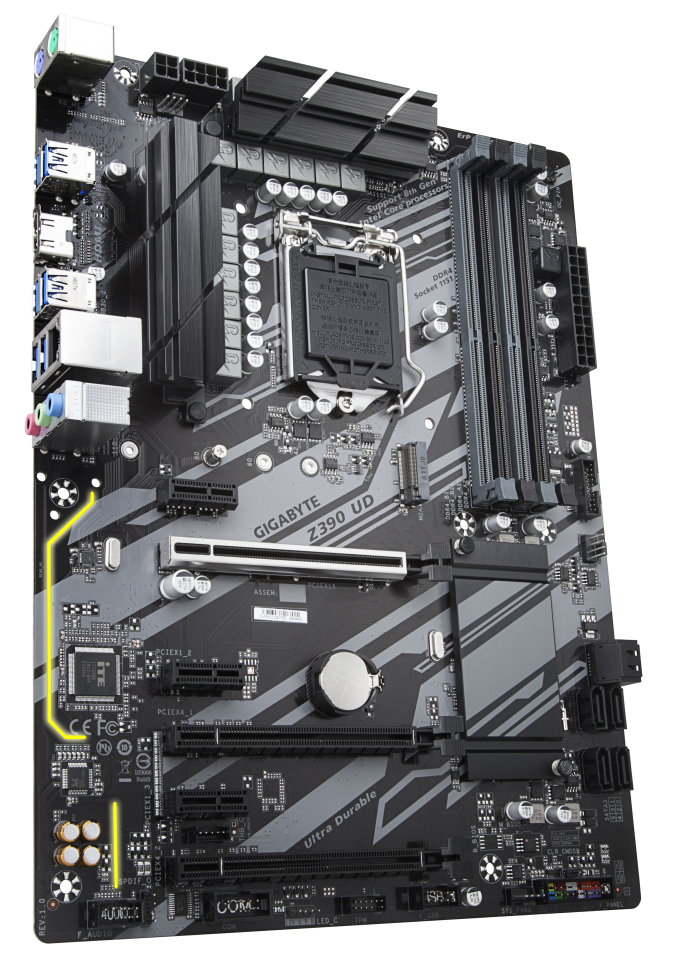Intel Z390 Motherboard Overview: 50+ Motherboards Analyzed
by Ian Cutress & Gavin Bonshor on October 8, 2018 10:53 AM EST- Posted in
- Motherboards
- Intel
- MSI
- Gigabyte
- ASRock
- EVGA
- Asus
- NZXT
- Supermicro
- Z390
GIGABYTE Z390 UD (Ultra Durable)
The GIGABYTE Z390 UD or Z390 Ultra Durable motherboard is ATX in size and drops all of the gaming branding and fluff associated with that for a cleaner and basic looking board. The black PCB has grey side sweeping straight patterning across the majority and combines it with the chipset heatsink. The board has a total of three full-length PCIe 3.0 slots with the top slot which is covered in metal slot protection supporting x16 and the two other bare full-length slots operating at x4; the board also features three PCIe 3.0 x1 slots. The board also has the same 8 and 4-pin 12V ATX power inputs as the Z390 Gaming SLI, Z390 Gaming X and Z390M Gaming models.
Storage wise the Z390 UD has a total of six SATA ports which are comprised of two right-angled connectors, with another bank of four featuring straight-angle connectors sitting just below. Above the PCIe slots is a single M.2 slot which supports both PCIe 3.0 x4 and SATA drives. For the memory up to a total of 64 GB can be installed across the four available RAM slots, with official XMP profiling currently being unannounced.
On the rear panel of the Z390 UD is a total of six USB 3.0 Type-A ports, a pair of PS/2 ports for a keyboard and mouse and an HDMI video output. This board drops any USB 3.1 Gen2 connectivity to shave on costs and isn't just the only GIGABYTE board to do so, but it's also using a cheaper Realtek ALC887 audio codec and Realtek RTL8111H Gigabit networking controller to power three 3.5 mm audio jacks and the single LAN port.
Without much pizazz and the gaming designed feature set, the Z390 UD (Ultra Durable) is targeted more towards budget systems and more professional users who aren't looking to spend extra budget on features deemed unnecessary which may for all intents and purposes remain unused. The Z390 UD costs $130 and as it stands, is the cheapest offering from GIGABYTE on Z390 as it represents one of the more modest entry-level Z390 offerings from any of the motherboard vendors at launch.












79 Comments
View All Comments
pawinda8 - Monday, October 15, 2018 - link
Still no mention of any Z390 boards with native Thunderbolt 3 (not AIC)! Has Intel given up on Thunderbolt for the PC world?gavbon - Monday, October 15, 2018 - link
If it's not integrated into the chipset, it's not really native as such. The ASRock Z390 Phantom Gaming-ITX/ac has a Thunderbolt 3 port on the rear panel, but that's the only one I'm afraidHikariWS - Monday, October 15, 2018 - link
Oculus Rift requires 3 USB3 ports and doesn't accept any of them being connected to a hub, they all need to be connected directly into a raw port. I had to buy a dedicated 3GIO USB 3 board that added 6 useful extra ports. In my (yes, old) Gigabyte z87 mobo I also had issues using keyboard and mouse on USB 3 ports inside UEFI and some recovery softwares, so I had to buy a USB 2 mirror to connect them.Because of that, having USB 2 ports on front panel and nice quantity of USB 3 is what most differs mobos for me, given that all other features are nearly the same.
ASUS Z390-A seems to be the best option. It has the important double USB2 ports, 5 USB3 ports and still has HDMI and DP for emergencies.
just4U - Monday, October 15, 2018 - link
I wish MSI had released a "godlike" board for the Ryzen series.ThugEsquire - Tuesday, October 16, 2018 - link
You list the ASRock Z390 Phantom Gaming-ITX/ac above as an ATX board, but it's actually mITX. FYIgavbon - Friday, October 19, 2018 - link
I have gone through every page where the Phantom Gaming-ITX/ac is listed, but I can't see where it says it's an ATX board? Could you please be more specific? Are you viewing on mobile or desktop?Galcobar - Tuesday, October 16, 2018 - link
It would be really helpful to break out one more criteria into a table: Type-C header for case-front ports.Helping a friend put together an i5 system and, knowing he'll keep it for a long time, am trying to get even with peripheral connectors (already has a monitor, so no using that as a hub). It's relatively easy to identify cases with a Type-C port, but that's pointless without a motherboard header. Having to go into each board's page to check is time-consuming.
jjnam - Thursday, April 18, 2019 - link
6 months later and I'm here for EXACTLY this reason. I've gone through probably 50 manuals over the past few days squinting to find this information. What a pain.Synomenon - Thursday, October 18, 2018 - link
So on the ASRock Z390 Phantom Gaming-ITX/ac, is the TB3 port on the rear using up lanes from CPU (making the only 16x slot, 8x only)?If it's not using lanes from the CPU, how will using that TB3 port (say with a USB3.1 Gen2 hub OR TB3 hub) affect all the other ports / IO on the board?
repoman27 - Thursday, October 18, 2018 - link
Going off of what TweakTown published, it's a single-port Intel JHL6240 "Alpine Ridge" controller with a PCI 3.0 x2 connection to the PCH. So it won't affect the PEG lanes from the CPU. I'm amazed it's not Titan Ridge at this point though.